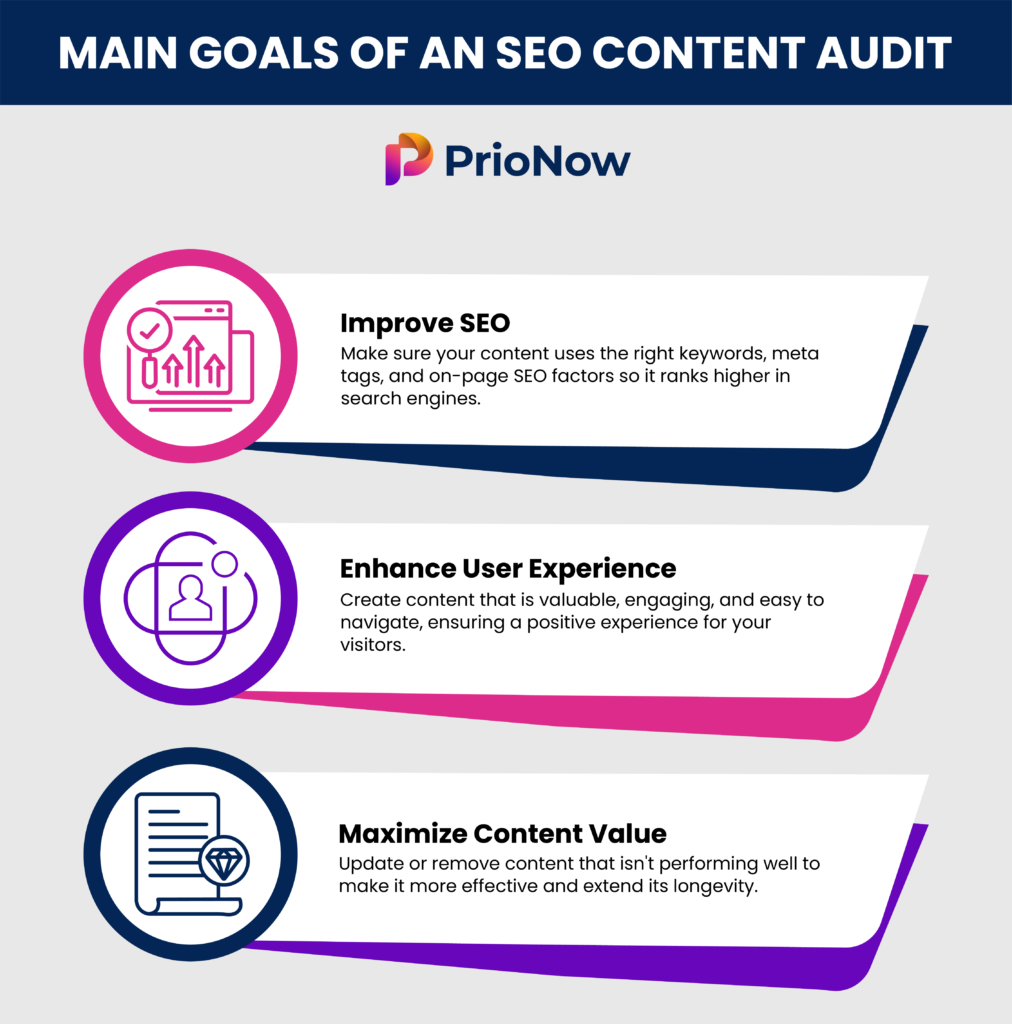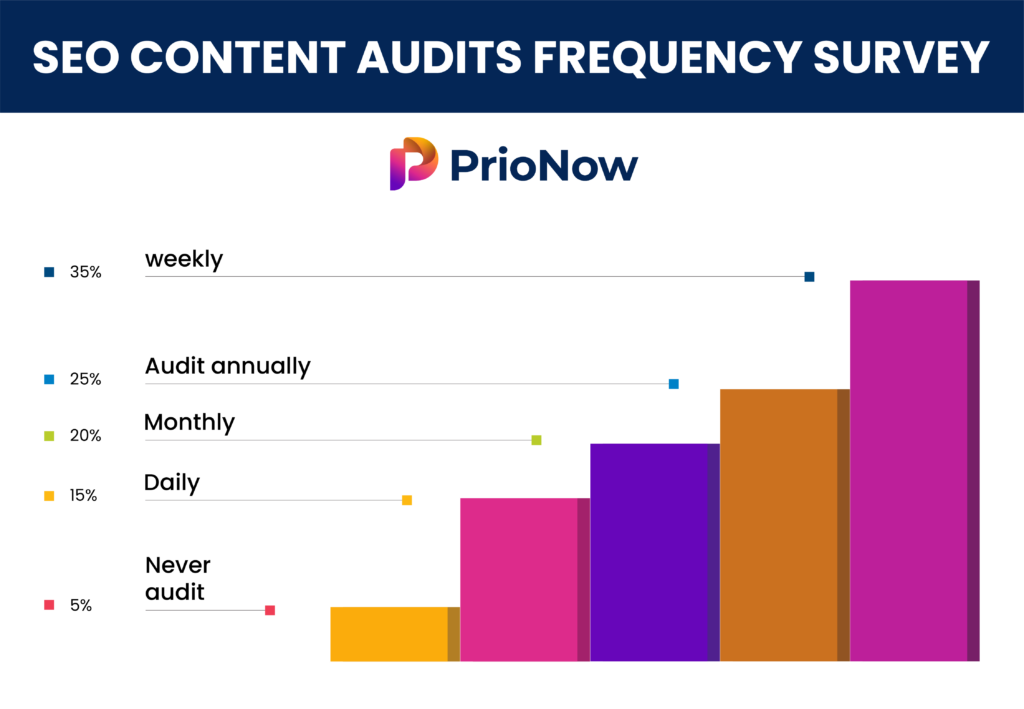An SEO content audit is a review of your website’s content to evaluate how well your pages are performing in line with your SEO goals.
Why is a Content Audit Useful, and What Are the Main Goals?
Content audits are essential for keeping your site competitive. They help you identify and resolve issues such as outdated content, keyword cannibalization, and underperforming pages. They also highlight opportunities, like pages that are close to ranking in top positions but need a little extra push.
Here are the three main goals of a content audit:
- Improve SEO: Make sure your content uses the right keywords, meta tags, and on-page SEO factors so it ranks higher in search engines.
- Enhance User Experience: Create content that is valuable, engaging, and easy to navigate, ensuring a positive experience for your visitors.
- Maximize Content Value: Update or remove content that isn’t performing well to make it more effective and extend its longevity.

Please note that website content audits differ from technical SEO audits, which focus on technical aspects like site speed, mobile-friendliness, indexing, and crawl errors.
How to Conduct a Comprehensive Website Review
There are different methods to perform a website audit. Here is our preferred approach:
- Define Clear Goals: No content audit will be successful without clearly defined goals. Review your performance based on the most important metrics for your website or business, such as clicks, engagement, conversions, or other key metrics.
- Content Inventory: Gather a list of all the pages on your website. Using tools like Google Analytics, Google Search Console, or PrioNow can make this process easier.
- Evaluate Content Performance: Assess each page’s performance based on your goals. Identify which pages are driving results and which ones need improvement.
- Optimize for Keywords: Ensure each page is optimized for the right keywords without overlapping with others. In other words, check for keyword cannibalization, which happens when multiple pages target the same keyword and compete against each other.
- Fill Content Gaps: Look for topics your audience is searching for that aren’t adequately covered on your site, especially for pages experiencing content decay. Analyzing competitors or related search terms can help you identify these gaps and create or expand content to fill them.
- Remove Low-Value Pages: Irrelevant content can hurt your site. Consider removing them to keep your site focused and valuable.
- Automate Regular Audits: SEO is an ongoing process, so regular content reviews help maintain and improve your site’s performance. Tools like PrioNow can help automate this process, making it easier to keep your content strategy up-to-date.
How Often Should You Review Your Website Content?
We recently conducted a survey on Reddit to understand how often content managers perform audits. Here’s what we found:
- 70% conduct regular audits:
- 15% daily
- 35% weekly
- 20% monthly
- 25% audit annually
- 5% never audit

Our survey shows that most SEO managers favor regular audits, with weekly reviews being the most common choice. This approach helps them keep content fresh while managing their workload effectively.
For larger websites, more frequent audits might be necessary to stay on top of your content. Ideally, content assessments should be ongoing because search trends and user behaviors change quickly. Traditional audits are often time-consuming, which can lead to less frequent checks.
Automation tools like PrioNow can simplify this process, helping you maintain an effective content strategy without the repetitive manual work.
Signs It’s Time for a Content Review
Here are some signs that indicate it’s time for a content audit:
- Decreasing Traffic: If you’re seeing a decline in traffic over time, it could mean your content isn’t resonating with your audience anymore, or your competitors have outranked you.
- Sudden Traffic Drops After Updates: A sharp drop in traffic after a search engine update might mean your site has been affected and needs a closer look.
- Falling Search Rankings: When your pages start slipping in search results for important keywords, it’s time to figure out why.
- Keyword Cannibalization: If multiple pages are competing for the same keyword, it can hurt your rankings. This issue should be addressed to ensure the correct page is ranking.
- Outdated Content: Content that hasn’t been updated in a while might not perform well because it’s no longer relevant to current trends.
- Low-Value Pages: Pages with little traffic or relevance might be dragging down your site’s overall performance.
- Low Engagement: If your pages rank well but people aren’t clicking on them, your meta titles and descriptions might need improvement.
Monitoring all these factors can be time-consuming and complex. A tool like PrioNow can help by tracking these signs and providing a comprehensive analysis to keep your content optimized.
How Long Does a Website Analysis Take?
The time required can vary depending on the size of your site. Smaller websites might take a few days, while larger ones could require several weeks.
To save time, we recommend automating data collection and analysis. Many tools can help gather data, but they often leave the analysis up to you. PrioNow, however, handles both tasks, making the process faster and easier.
What Are the Costs?
The cost of a professional content audit varies based on the scope, size, and depth of the review. Basic audits may start at a few hundred dollars, while more comprehensive audits for larger sites can run into several thousand.
For example, at an hourly rate of $100, auditing 200 pages (based on the minimum 5 minutes per page) could cost you around $1,600. However, using a content audit tool like PrioNow offers a more budget-friendly solution that can save you both time and money in the long run.
Conclusion
Regular SEO content audits keep your website competitive and performing well. By consistently reviewing and optimizing your content, you can get more value from it. Automating the process with tools like PrioNow can save you time and make it easier to maintain an effective content strategy.
